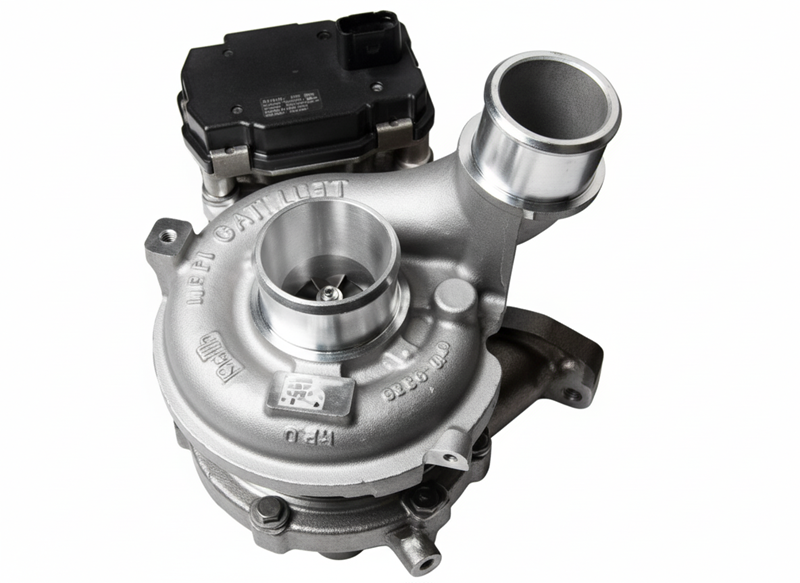If your turbo diesel ute feels sluggish, or you’re noticing a mysterious whistle from the engine bay, the problem likely points to your Variable Nozzle Turbine (VNT) system. Particularly common in Australian turbo diesels, this clever technology uses a VNT actuator to control the turbo’s behaviour. When it fails, your reliable diesel can quickly become a smoky, frustrating nightmare.
The VNT actuator is the “brain” of your variable geometry turbocharger. It precisely adjusts movable vanes inside the turbo housing to control the exhaust gas flow. This mechanism provides optimal boost across the entire rev range—giving you quick spool-up at low speeds and preventing over-boosting at high revs. Your diesel engine’s performance, fuel economy, and emissions all depend on a healthy, well-functioning VNT actuator.
The VNT Actuator’s Role in Performance
- Low Engine Speeds: Vanes close to increase exhaust gas velocity, minimising turbo lag and allowing the turbo to spool quickly.
- High Engine Speeds: Vanes open progressively to maintain optimal boost, prevent engine damage, and ensure smooth power delivery.
Spotting Failure: Common VNT Actuator Symptoms
A faulty VNT actuator gives off clear warning signs. Ignoring these symptoms can lead to more serious, wallet-crushing repairs. A faulty VNT actuator gives off clear warning signs. Ignoring these symptoms can lead to more serious, wallet-crushing repairs. You might notice a sudden loss of power, poor fuel economy, or sluggish turbo response. The engine may hesitate during acceleration, and you could even hear unusual whistling or whining noises coming from the turbo area. In some cases, your vehicle may go into limp mode to protect the engine, leaving you with reduced performance. Addressing these issues early can prevent costly damage to your turbocharger and engine components. Regular maintenance and diagnostics help ensure your actuator performs efficiently and reliably.
Key Warning Signs of a Failing Actuator
The most obvious indicator is a noticeable loss of power and sluggish acceleration. Your diesel that once “pulled like a train” now feels like it’s dragging an anchor, especially when towing. This occurs because the vanes are not positioned correctly, disrupting the crucial balance of boost pressure.
- Excessive Exhaust Smoke: Black smoke is a classic sign of over-fuelling due to insufficient boost—the actuator isn’t opening the vanes enough to generate proper airflow.
- Increased Turbo Lag: You press the accelerator and wait, and wait, before the engine delivers power. This makes overtaking potentially unsafe.
- Strange Turbocharger Noises: Whistling can indicate boost leaks, while grinding suggests the vanes are sticking due to carbon buildup.
Unlocking Power: VNT Actuators and Diesel Engine Tuning
Understanding how your VNT actuator works is crucial when seeking to increase BHP of a diesel car. A properly calibrated unit is the first step to a performance upgrade.
Actuator Health and Power Gains
The VNT actuator directly dictates when and how much boost your engine receives. An upgraded or fine-tuned actuator can safely increase boost levels, translating directly into more torque and power without necessarily requiring other component changes immediately.
The relationship between a responsive actuator and fuel efficiency is also critical. When boost arrives exactly when needed, your engine operates more efficiently, reducing throttle input needed for the same performance.
- Electronic Actuators: Offer superior precision, allowing for aggressive but safe adjustment through ECU remapping to maximise gains.
- Mechanical Actuators: Can be adjusted for quicker response and higher peak boost, though they offer less flexibility than electronic units.
Fine-tuning your actuator is key to achieving significant diesel engine performance improvements while maintaining reliability.
Upgrade vs. Replace: Making the Best Decision
Deciding whether to replace a failed VNT actuator or invest in a turbo upgrade diesel solution depends on its current condition and your performance goals. However, if you’re chasing significant power gains, improved towing capacity, or simply want to future-proof your vehicle with better components, a full diesel turbo upgrade is the superior investment. An upgrade typically involves a larger compressor wheel, potentially a different turbine housing, and a unit designed to flow more air, allowing for higher horsepower and torque that the standard turbo was never intended to produce. This decision shifts the focus from repairing a fault to enhancing performance.
Costs and Performance Expectations
Cost considerations extend beyond the part. Labour costs in Australian workshops can be $150+ per hour, making DIY installation tempting for the mechanically inclined. However, professional installation is essential for proper calibration. Incorrect adjustment can lead to catastrophic over-boost situations.
The Role of ECU Remapping
ECU remapping after an actuator or turbo upgrade is often essential. The engine’s computer must be adjusted to take advantage of the new boost characteristics, safely increasing fuel delivery and timing. This can unlock an additional 20–30% power on top of the physical upgrade.
Installation, Maintenance, and Popular Australian Applications
Whether you choose a simple replacement or a complex Garrett T3 turbo upgrade, proper installation and long-term care are non-negotiable for diesel turbos reliability.
Installation Pitfalls and Calibration
VNT actuator replacement is a precision job. Common pitfalls include incorrect linkage adjustment, which causes binding or insufficient vane travel. Calibration requires setting the actuator arm position at specific boost levels—getting this wrong compromises performance at best and risks engine failure at worst.
Targeting the 1HZ Engine
The legendary Toyota 1HZ engine, popular in the 80 Series LandCruiser, is a prime candidate for turbo upgrades. Kits like the DTS turbo kit 1HZ or Denco turbo kit 1HZ include carefully matched actuators designed for the engine’s characteristics. For reliable towing and touring, conservative boost levels around 10–12 psi are highly recommended.
Preventing Actuator Failure
The most common cause of actuator failure is sticking vanes due to carbon buildup from short trips or poor fuel quality.
- Use high-quality synthetic oils for regular changes.
- Allow the engine to idle briefly after hard driving to cool the turbo.
- Perform regular “Italian tune-ups” (high-load runs) to help clean out carbon.
- Monitor boost pressure and exhaust gas temperatures (EGT) with dedicated gauges.
Conclusion:
Whether you’re restoring lost power or chasing more torque, understanding your VNT actuator is the first step to unlocking your diesel’s full potential. By understanding the vital role of the VNT actuator in your turbo diesel system, you can ensure longevity, improve fuel economy, and consistently enjoy the powerful performance your vehicle was designed to deliver. For the best results, always choose quality components and get the best deal on VNT actuator from reputable Australian suppliers to guarantee reliability and long-term value.






Leave a Reply